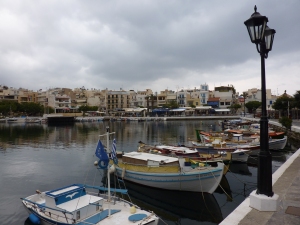When in Rome…or other places, I like to read in context with my travels. So last week while cruising the Greek isles and a couple of neighboring Turkish ports, I explored the timeless novel by Nikos Kazantzakis, none other than Zorba the Greek! What an engaging exploration of the human spirit seen from two distinctly different viewpoints. The detail and descriptions are fantastic. This observation on the part of the narrator, Boss, hit a chord so perfectly within me that it resonated a concept that we all must ponder…what are our needs, our comforts, and our pleasures when it comes to interior design?
“It is a great pleasure to enter a Cretan peasant’s home. Everything about you is patriarchal: the hearth, the oil lamp, the earthenware jars lining the wall, a few chairs, a table and, on the left as you enter, in a hole in the wall, a pitcher of fresh water. From the beams hang strings of quinces, pomegranates and aromatic plants: sage, mint, red peppers, rosemary and savory.
At the far end of the room a ladder for a few wooden steps lead up to the raised platform, where there is a trestle bed and, above it the holy icons with their lamps. The house appears empty, but it contains everything needful, so few in reality are the true necessities of man.”
It seems as we start out in life, that we want to gather things, express our interests, and decorate with the stuff that says who we are…then later, many people want to reduce the clutter, eliminate the maintenance and strive for a simpler life. This too can be said in light of catastrophes like the recent earthquake and tsunami in Japan. The devastation that robbed so many of their things and even their loved ones certainly puts things in perspective.
But healthy consumerism and the capitalistic way of life that encourages, promotes and rewards the buying and selling to keep the machine in motion is a far cry from this simple scene. But for a moment, pause and re-read those two paragraphs and wonder if it doesn’t come back to architect, Mies Van der Rohe’s famous phrase that he adopted from painter Andrea del Sarto that “less is more”? Or in the case of the peasant’s house…less is enough.
Recent Blog Posts
- DOWNSIZING: Part Two of Three February 21, 2025
- DOWNSIZING: Part One of Three November 5, 2024
- Colors and the Creamy Attraction of Latte August 29, 2024
- Designing, Styling and Why – Finding Personal Style April 30, 2023
- Fabrics – Texture, color, pattern, design & style – The Art of Transformation August 7, 2022
Get in Touch!
Come Visit Us!
216 GOLD AVENUE
ALBUQUERQUE, NM 87102
MON-FRI: 9 AM – 5 PM
SAT-SUN: 9 AM – 2 PM


